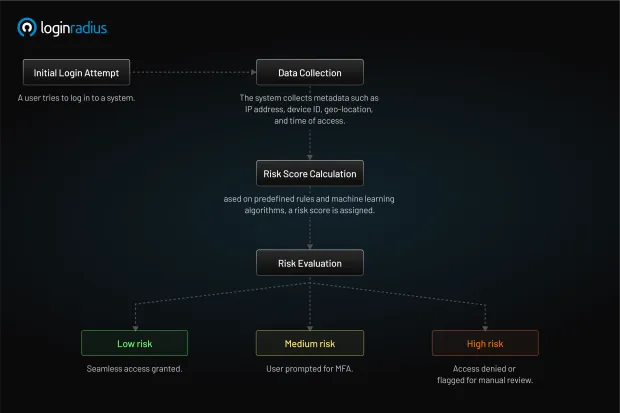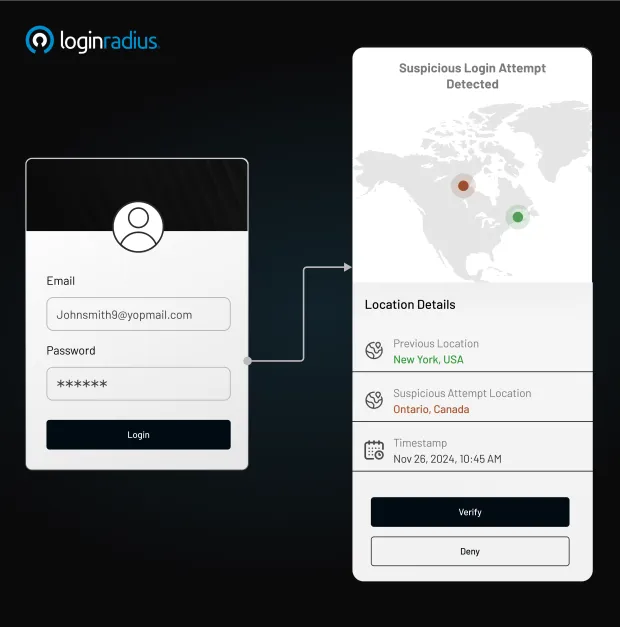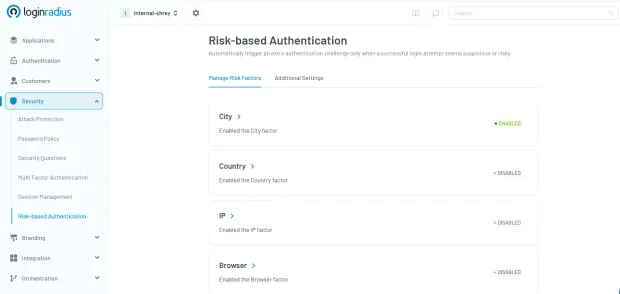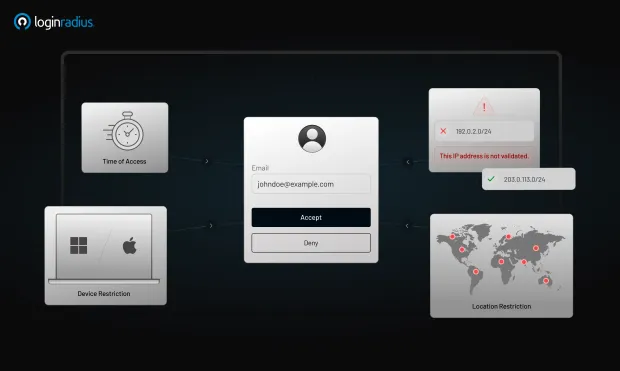What is Risk-Based Authentication (RBA)?
Risk-Based Authentication (RBA) intelligently adapts login security by evaluating contextual and behavioral signals in real time. It minimizes friction for trusted users while blocking suspicious attempts with dynamic MFA. Explore how RBA strengthens both user experience and security across industries.


Learn How to Master Digital Trust

The State of Consumer Digital ID 2024

Top CIAM Platform 2024
Introduction
In an era of advanced cyber threats and evolving user expectations, organizations must strike a balance between robust security and seamless user experience. Risk-based authentication (RBA) is the key to achieving this equilibrium.
Instead of enforcing a one-size-fits-all authentication method, RBA dynamically adjusts the level of user verification based on the risk profile of each login attempt.
This blog dives deep into what is risk based authentication, its working model, benefits, examples, and best practices to implement it effectively.
What is Risk Based Authentication (RBA)?
Risk-based authentication is an intelligent security mechanism that evaluates the context of a login attempt and adjusts authentication requirements accordingly.
Also referred to as risk-based adaptive authentication or adaptive authentication, this method is a more intelligent evolution of traditional authentication approaches. Rather than applying the same static rules to every login attempt, it dynamically analyzes various contextual signals such as device type, user location, IP address, and behavioral patterns in real time.
By embedding context-awareness into the core of the authentication process, risk-based systems can evaluate the likelihood of a login attempt being legitimate or malicious. If the login behavior aligns with previously observed, trusted patterns—say, from a recognized device in a familiar location—the system classifies the attempt as low risk and grants access with little to no friction. On the other hand, if the behavior is unusual or inconsistent with historical data, the system escalates the verification process.
This escalation typically includes an additional layer of multi-factor authentication, requiring the user to provide more than one form of identity verification, such as a one-time password or biometric scan. This ensures that even if credentials are compromised, unauthorized access is still blocked.
Risk-based authentication strengthens not just security but also the overall user experience. It avoids burdening users with unnecessary challenges when the context is safe, while still providing strong safeguards in high-risk scenarios. By continuously analyzing behavior and adjusting requirements in real time, it becomes a key mechanism in modern identity architectures.
What is RBA used for? Its primary role is to protect against threats like credential stuffing, session hijacking, and brute-force attacks. As part of broader identity risk management strategies, risk-based authentication helps organizations minimize fraud, maintain trust, and adapt security in line with today’s evolving digital environments.
The Evolution of Authentication Methods
Authentication, the process of verifying identity before granting access, has been a fundamental element of security since the earliest days of computing.
The first password-based authentication system was introduced in 1961 at MIT, developed by Fernando Corbató for the Compatible Time-Sharing System (CTSS), allowing multiple users to share a computer while keeping their data private. (Source: Smithsonian Magazine)
As digital systems grew more complex, so did the need for stronger methods of verifying user identities. Throughout the 1980s and 1990s, authentication systems primarily relied on static credentials—passwords and PINs. These were sufficient for closed, local systems but began to falter with the rise of the internet and global connectivity.
The Limitations of Single-Factor Authentication
Single-factor authentication (SFA)—which relies on just one method of verification, typically a password—became the standard approach across most digital platforms during the early days of internet adoption. However, as cyber threats grew more advanced, this model proved increasingly vulnerable. Attackers began exploiting common user habits such as weak, reused, or stolen passwords.
In fact, the Verizon 2025 Data Breach Investigations Report highlights that over 80% of hacking-related breaches involved the use of compromised or stolen credentials, underscoring the limitations of relying solely on passwords for security.
The Rise of Two-Factor and Multi-Factor Authentication
In response to the growing weaknesses of password-only systems, the early 2000s saw the widespread adoption of two-factor authentication (2FA) and later, multi-factor authentication (MFA). These models introduced layered security by requiring users to verify their identity through two or more independent credentials—typically categorized as something the user knows (e.g., password or PIN), has (e.g., security token or mobile device), or is (e.g., fingerprint or facial recognition).
This marked a significant step forward in protecting user identities and sensitive systems. Even if one factor (like a password) was compromised, the attacker would still need access to an additional authentication method to gain entry. As a result, MFA drastically reduced the success rate of credential-based attacks.
Recognizing its effectiveness, cybersecurity authorities such as the National Institute of Standards and Technology (NIST) emphasized the importance of MFA in their digital identity guidelines, particularly in NIST SP 800-63B, which outlines best practices for digital identity assurance.
Despite its strengths, MFA isn't without limitations. User friction is a primary concern—requiring multiple steps for authentication can lead to frustration and decreased user satisfaction, especially in consumer-facing applications. Additionally, inconsistent implementation and adoption across platforms and user segments further weaken its overall effectiveness.
Compared to static MFA, risk-based authentication (RBA) offers a more intelligent and context-aware solution. While MFA applies the same verification steps to all users regardless of circumstance, RBA dynamically adjusts the authentication process based on the assessed risk of each login attempt.
The Shift Toward Adaptive and Risk-Based Security
As digital transformation accelerated and cyber threats grew in complexity, it became clear that static security models—no matter how layered—were no longer enough. This realization spurred the evolution of risk based security models, giving rise to more intelligent, adaptive approaches to identity verification. Among these, risk based authentication (RBA) emerged as a standout solution.
RBA represents a shift from one-size-fits-all security to context-aware authentication. Unlike traditional MFA, which treats every login attempt with the same level of scrutiny, RBA continuously analyzes contextual factors to determine whether a login should be trusted, challenged, or denied.
These contextual signals include device fingerprinting, geolocation, IP reputation, browser metadata, and even user behavioral patterns such as time-of-day access and typing cadence.
Let’s say a user logs in from their usual laptop at home at their regular time—RBA detects this as low risk and allows seamless access. But if the same credentials are used from an unfamiliar device in another country, especially at an odd hour, the system flags this as a high-risk event.
In such cases, RBA might enforce step-up authentication, such as requiring a biometric scan or an OTP, before granting access.
This adaptability is what sets RBA apart. It intelligently reduces false positives (flagging legitimate users) and mitigates false negatives (letting attackers slip through), something static MFA struggles to achieve on its own.
It also helps reduce user frustration by eliminating unnecessary authentication challenges for trusted behavior—making it a vital component of a frictionless, secure digital experience.
For enterprises, especially those managing high-value or large-scale customer interactions, implementing RBA isn’t just beneficial—it’s essential. RBA supports zero trust architecture, scales efficiently across geographies, and aligns with compliance standards like GDPR and HIPAA. It strengthens both security posture and customer experience simultaneously.
Curious how RBA can be implemented across your enterprise environment? Download our comprehensive guide:
RBA is more than a trend—it’s a forward-looking approach to identity security that adapts to users and threats in real time. As attack surfaces grow, solutions like RBA will be at the core of securing access without slowing business down.
RBA in the Era of Decentralized Identity
As organizations adopt open source authentication frameworks and move toward decentralized identity systems, adaptive models like RBA are becoming foundational. These approaches are well-suited to support zero trust architectures and deliver the balance of security and usability that modern digital environments demand.
Want a deeper dive into authentication methods? Explore our full comparison of 1FA vs 2FA vs MFA to understand how authentication strategies have evolved and where they’re headed.
What are the Benefits of Using Risk-Based Authentication?
Organizations leveraging RBA gain a competitive edge in security and user experience. Here are key benefits:
-
Enhanced Security: By identifying anomalous behavior, RBA blocks unauthorized access proactively.
-
Reduced Friction: Legitimate users enjoy frictionless login experiences when risk is low.
-
Real-Time Decision Making: Contextual data is analyzed instantly, ensuring timely and accurate decisions.
-
Cost Efficiency: Fewer false positives reduce operational costs and helpdesk tickets.
-
Compliance and Trust: RBA supports data protection regulations and boosts customer confidence.
Moreover, combining RBA with risk based access control frameworks ensures fine-grained authorization policies.
How Does Risk-Based Authentication Work?

RBA relies on behavioral analytics and contextual data. Here's a step-by-step breakdown:
-
Initial Login Attempt: A user tries to log in to a system.
-
Data Collection: The system collects metadata such as IP address, device ID, geo-location, and time of access.
-
Risk Score Calculation: Based on predefined rules and machine learning algorithms, a risk score is assigned.
-
Risk Evaluation:
-
Low risk: Seamless access granted.
-
Medium risk: User prompted for MFA.
-
High risk: Access denied or flagged for manual review.
-
This adaptive model is central to risk authentication strategies in modern digital identity systems. As remote work and BYOD (Bring Your Own Device) trends grow, RBA offers a scalable way to protect distributed digital environments.
How is the RBA Risk Score Calculated?
The effectiveness of risk-based authentication hinges on how accurately the system can assess the risk of each login attempt—and that starts with how the risk score is calculated.
At its core, the RBA risk score is computed using a combination of contextual and behavioral signals. These factors are analyzed in real time to determine whether access should be seamless, challenged with additional verification, or outright denied.
Key Risk Indicators Include:
- User Behavior Patterns: Any deviation from a user's normal behavior—like logging in at odd hours or accessing new features unexpectedly—can trigger a higher risk score.

- Device Information: If a login attempt comes from a previously unseen device or a jailbroken/rooted one, the system marks it as higher risk.

- Geo-Velocity: If the system detects two logins from distant locations within a short time (e.g., New York to Tokyo in 5 minutes), it identifies it as an anomaly.

- IP Address Reputation: Connections originating from blacklisted IPs, proxy services, or known malicious ranges are flagged immediately.
To help security teams implement these factors effortlessly, the LoginRadius Identity Platform offers a dedicated Risk-Based Authentication console. As shown below, administrators can easily enable or disable specific risk signals like City, Country, IP, and Browser, tailoring the system to their organization’s unique threat landscape:

This intuitive interface allows teams to configure their identity risk management parameters with precision, ensuring that only risky behaviors trigger multi-step verification—while keeping the user experience smooth for legitimate users.
With LoginRadius, RBA isn't just a concept—it's a configurable, real-time security layer ready for deployment in high-risk environments, whether it's consumer applications, enterprise systems, or regulated industries.
Examples of Risk-Based Authentication
Understanding real-world scenarios helps illustrate how RBA functions:
-
Unusual Login Location: A user logs in from a different country for the first time. RBA flags this and initiates MFA.
-
New Device Access: A new, unrecognized device triggers a challenge.
-
Odd Login Time: A midnight login by a 9-to-5 employee results in a higher risk score.

These use cases show how risk-based MFA kicks in only when contextually needed, maintaining both security and UX.
Real-World Applications of Risk-Based Authentication Across Industries
1. Retail & E-commerce: Secure Checkout, Frictionless Experience
In retail environments, balancing robust security with a smooth user journey is essential. LoginRadius' adaptive RBA model ensures legitimate customers enjoy seamless access while high-risk attempts, such as credential stuffing or account takeover, are flagged. Discover how this works in our feature on advanced risk-based authentication for retail, where we break down practical applications for securing the digital storefront.
2. Healthcare: Protecting Patient Data With Precision
While not always made public in case studies, RBA has critical applications in healthcare—particularly for telehealth and remote access scenarios. By dynamically adjusting authentication based on real-time risk analysis, healthcare providers can meet both security and compliance requirements. This approach supports patient privacy, especially in alignment with HIPAA and other regulatory frameworks.
3. Gaming: Stopping Fraud Without Impacting Play
LoginRadius enables gaming platforms to detect suspicious behavior—such as logins from unusual locations or devices—while allowing regular players seamless access. This adaptive approach is detailed in our blog on risk-based authentication in the gaming industry, where we explore how to reduce fraud without compromising the player experience.
What Makes a Good Risk-Based Authentication Solution? Best Practices
When evaluating or designing an effective risk-based authentication (RBA) system, several best practices help ensure you strike the right balance between security and user experience:
-
Contextual Intelligence: A strong RBA solution must assess contextual signals like device fingerprinting, IP analysis, geolocation, and browser behavior. These indicators help build a reliable risk profile for each login attempt.
-
Machine Learning Integration: Leveraging AI enables the system to adapt and refine its risk models continuously. This is especially important in dynamic environments where threats evolve quickly and user behavior patterns shift.
-
Real-Time Processing: RBA must operate with minimal latency. Delayed decisions can frustrate users and give attackers room to exploit security gaps. Systems should process contextual data and enforce policies instantly.
-
Customization: Different industries, compliance frameworks, and user roles require different levels of risk sensitivity. A robust solution should offer granular policy configuration so administrators can define what constitutes “risky” behavior in their specific context.
-
Interoperability: Enterprises often operate within complex tech stacks. A reliable RBA solution should integrate smoothly with existing IAM systems and support open standards. LoginRadius offers built-in B2B Partner IAM and Organizations Management, enabling seamless deployment of RBA across multi-tenant and partner environments with centralized control.
-
User Transparency: Clearly communicating why a step-up challenge was triggered builds user trust. A good RBA system doesn’t just secure—it also enhances the user experience by adapting silently in the background when risk is low.
This is exactly where LoginRadius excels. The platform offers a configurable, enterprise-ready RBA engine with real-time contextual evaluation, AI-driven risk scoring, and seamless integration into your IAM stack.
Administrators can easily fine-tune risk factors such as IP, device, location, and browser via a dedicated dashboard—ensuring both security teams and end users benefit from smarter, adaptive authentication.
Whether you're building for compliance-heavy industries or high-growth consumer platforms, LoginRadius delivers the intelligence and flexibility needed to implement RBA the right way. You can explore full technical capabilities and implementation steps in our developer documentation.
Summary
Risk-Based Authentication (RBA) is transforming identity security by adding intelligence and adaptability to access decisions. Unlike static systems, RBA continuously evaluates risk and enforces just the right level of security.
Organizations that implement RBA benefit from improved protection, lower friction, and compliance readiness. From preventing fraud to enhancing trust, RBA is a cornerstone of modern CIAM.
By integrating with risk based access control, open source risk management, and adaptive technologies, RBA stands at the forefront of the future identity landscape.
Ready to explore how RBA can strengthen your digital security? Contact our team to get started.
FAQs
1. How is Continuous authentication different from risk-based?
A. Continuous authentication constantly monitors user activity during a session, whereas risk-based authentication assesses risk at specific checkpoints like login or transaction.
2. How does one implement risk based authentication?
A. Start with defining risk policies, collecting contextual data, integrating risk engines with IAM platforms, and testing thresholds for different user scenarios.
3. What is risk verification?
A. Risk verification is the process of assessing whether a user’s identity and activity align with expected patterns, often leading to step-up authentication if needed.
4. How is dynamic authentication different from static authentication?
A. Dynamic authentication adapts based on risk or behavior, while static methods use the same steps for all users regardless of context.


